UnderMiner
Silver Member
- Jul 27, 2014
- 3,818
- 9,726
- 🥇 Banner finds
- 2
- Detector(s) used
- Minelab Excalibur II, Ace 250
- Primary Interest:
- All Treasure Hunting
Here's today's epic treasure adventure story:
With these last few days being relatively warm I decided to hit one of my favorite old spots out on the island... I didn't expect to find much - boy was I wrong. I started out detecting the tree line where I left off last month and almost immediately found my first silver - a little .925 broken locket. A few minutes later I found an ancient copper spoon, then a 1941 Washington and a worn-out nickle. I then dug an 1887 Indian! Amazing, can't get much better than this right?
I was about to pack up and head over to another site when I got a really high tone. Dug down and saw something... something eerily familiar... it was a silver shaker cap. Though slightly different in appearance it looked like the style of the 1738 Colonial pepper pot I had found here last month! Could there be more colonial silver trinkets out here, I thought, or even an ancient colonial treasure of epic proportions?! Maybe a forgotten pirate came to Long Island long ago and buried some treasure here! Romantic historical fantasies took hold of me. Bent on finding more treasure I quickly made a rudimentary grid in the dirt and began checking everywhere in it.
I found a clad quarter, some melted lead, a broken clay pipe, a few pieces of extremely rusty iron, and then... a high signal... perhaps another copper spoon or silver coin? Dug down 6 inches very carefully and... time stopped. There was a topless silver pepper shaker. Completely compacted with dirt both inside and out. How?! Why?! This never happens! Holy $#*%! This was too much excitement, this was the other half of the lost shaker that that silver cap goes to!
Back at home I cleaned the dirt out of the inside of the shaker and then I straightened the rim of the silver cap I had found earlier. The two pieces fit together perfectly! This was indeed yet ANOTHER complete colonial-era silver pepper pot! This had to be the mate to the other pepper pot I had found in that area last month, I thought! I quickly took out the original 1738 shaker and compared the two. Although they looked nearly identical on the outside their hallmarks were very different from each other. Maybe they were together when they were lost, but they were not a mated pair.
Edit: I've just been informed by Crusader that this artifact was not made in London as some of my previous sources had indicated. This was made in the city of Exeter, making it a far rarer artifact than my first London-made pepper pot. Since this piece was made in Exeter the date of manufacture must now also be different. It can not be from 1718, as this is the date according to London markings only, according to the Exeter hallmark chart this piece was most likely made in 1703. As for the actual maker, this is still unknown. I will keep you all posted. One thing is for certain this piece, although it is a similar style to the previous shaker I found, is not part of a "set" with it. It is possible the two shakers had the same owner and were lost at the same time but they were definitely not originally used together as they differ in age by 35 years and were made in different cities.
Edit 2: Okay, new revelation! I've been calling these things "pepper pots" but I just discovered they are officially called "Bun Peppers". According to a website on old tableware, "Bun Peppers were only made during the reigns of George I and George II. They appear to have been made singly and not very decorated. They were most likely used during less formal occasions."
I also discovered that the maker is most likely James Whipple. His stamp was "JW&Co" this is the only Exeter maker's mark that has the last letters as "Co" and this matches up with the "Co" on the bottom of the shaker.
Today's finds:
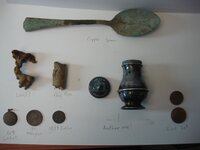
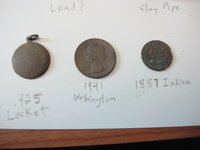
Putting the cap back on after 200+ years in the ground:
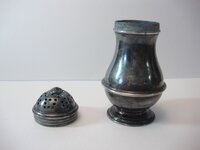
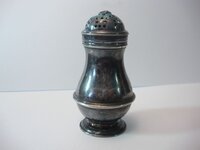
The holes on this one are nearly twice the size compared to the original one:
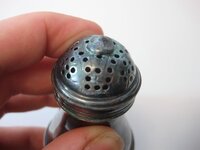
The two shakers (1703 on left 1738 on right) The tops and bases are noticeably different:
This must have been a popular style. These two although similar looking are actually not related,
they were made 35 years apart in two different cities by two different silver smiths:
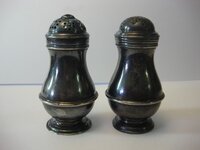
The hallmarks of the latest shaker (left) compared to my original (right):
The one on the left from 1703 Exeter while the one on the right is from 1738 London.
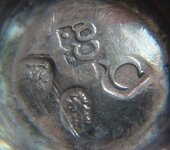
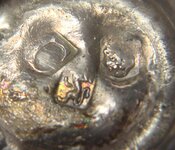
With these last few days being relatively warm I decided to hit one of my favorite old spots out on the island... I didn't expect to find much - boy was I wrong. I started out detecting the tree line where I left off last month and almost immediately found my first silver - a little .925 broken locket. A few minutes later I found an ancient copper spoon, then a 1941 Washington and a worn-out nickle. I then dug an 1887 Indian! Amazing, can't get much better than this right?
I was about to pack up and head over to another site when I got a really high tone. Dug down and saw something... something eerily familiar... it was a silver shaker cap. Though slightly different in appearance it looked like the style of the 1738 Colonial pepper pot I had found here last month! Could there be more colonial silver trinkets out here, I thought, or even an ancient colonial treasure of epic proportions?! Maybe a forgotten pirate came to Long Island long ago and buried some treasure here! Romantic historical fantasies took hold of me. Bent on finding more treasure I quickly made a rudimentary grid in the dirt and began checking everywhere in it.
I found a clad quarter, some melted lead, a broken clay pipe, a few pieces of extremely rusty iron, and then... a high signal... perhaps another copper spoon or silver coin? Dug down 6 inches very carefully and... time stopped. There was a topless silver pepper shaker. Completely compacted with dirt both inside and out. How?! Why?! This never happens! Holy $#*%! This was too much excitement, this was the other half of the lost shaker that that silver cap goes to!
Back at home I cleaned the dirt out of the inside of the shaker and then I straightened the rim of the silver cap I had found earlier. The two pieces fit together perfectly! This was indeed yet ANOTHER complete colonial-era silver pepper pot! This had to be the mate to the other pepper pot I had found in that area last month, I thought! I quickly took out the original 1738 shaker and compared the two. Although they looked nearly identical on the outside their hallmarks were very different from each other. Maybe they were together when they were lost, but they were not a mated pair.
Edit: I've just been informed by Crusader that this artifact was not made in London as some of my previous sources had indicated. This was made in the city of Exeter, making it a far rarer artifact than my first London-made pepper pot. Since this piece was made in Exeter the date of manufacture must now also be different. It can not be from 1718, as this is the date according to London markings only, according to the Exeter hallmark chart this piece was most likely made in 1703. As for the actual maker, this is still unknown. I will keep you all posted. One thing is for certain this piece, although it is a similar style to the previous shaker I found, is not part of a "set" with it. It is possible the two shakers had the same owner and were lost at the same time but they were definitely not originally used together as they differ in age by 35 years and were made in different cities.
Edit 2: Okay, new revelation! I've been calling these things "pepper pots" but I just discovered they are officially called "Bun Peppers". According to a website on old tableware, "Bun Peppers were only made during the reigns of George I and George II. They appear to have been made singly and not very decorated. They were most likely used during less formal occasions."
I also discovered that the maker is most likely James Whipple. His stamp was "JW&Co" this is the only Exeter maker's mark that has the last letters as "Co" and this matches up with the "Co" on the bottom of the shaker.
Today's finds:


Putting the cap back on after 200+ years in the ground:


The holes on this one are nearly twice the size compared to the original one:

The two shakers (1703 on left 1738 on right) The tops and bases are noticeably different:
This must have been a popular style. These two although similar looking are actually not related,
they were made 35 years apart in two different cities by two different silver smiths:

The hallmarks of the latest shaker (left) compared to my original (right):
The one on the left from 1703 Exeter while the one on the right is from 1738 London.


Amazon Forum Fav 👍
Last edited:
Upvote
34





 I just posted on Friday a very belated congrats on your first colonial-period shaker from last month. I felt bad not complimenting you on it and figured better late than never. Now you've done it all over again three days later. Man, the detecting gods have been smiling down at you. Can I stand next to you to catch some of that good fortune in the afterglow?
I just posted on Friday a very belated congrats on your first colonial-period shaker from last month. I felt bad not complimenting you on it and figured better late than never. Now you've done it all over again three days later. Man, the detecting gods have been smiling down at you. Can I stand next to you to catch some of that good fortune in the afterglow? 


 :
:

 Splendid times two!
Splendid times two! 


